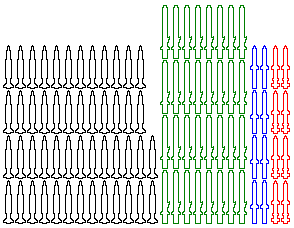Understanding JMSDF Hull Numbers
 |
| A JMSDF Helicopter Destroyer (140-series hull number) and Missile Boat (800-series hull number) |
The JMSDF utilizes a hull designation system that is on the surface quite similar to that of the USN. However, a second look will reveal that it does not follow the same rules. Hull designations are not unique (there have been two of DD-101 through DD-119) and numbers are assigned out of order (DD-101 immediately followed DD-158). But on closer examination, one will discover that it actually conveys more information than the USN system.
The principle that must be remembered is that, in contrast with the USN, it is the numbers that are the key while the letters are actually somewhat redundant. All JMSDF ships, regardless of letter designations, follow the same set of rules for number designations. The first rule is that the leading digit of a ship’s number (when combined with the total number of digits) reveals her general class - for instance, all destroyers have a number in the 100 range. However, it should be noted that these ranges begin with 1 and not 0. Thus, 600 is actually part of the 500 series.
100 - first-rate surface combatants
200 - second-rate surface combatants
300 - ocean minesweepers
400 - major auxiliaries
500 - submarines
600 - coastal minesweepers
800 - missile boats
3000 - training ships
4000 - minor auxiliaries
5000 - research ships
6000 - experimental ships
The second rule is that next digit is used to designate subtypes of ships. The principles are difficult to summarize, so I will demonstrate them with a brief history of JMSDF surface combatant and submarine hull numbers.
Unlike in the USN system, all destroyers (DD, DDG, and DDH - but not DE) share the same numeric sequence. This sequence began with the first post-war destroyers and ran DD 101-133. However, there were also four destroyers transferred from the USN that were designated 181-184, presumably to distinguish them from the Japanese-built ships. Another sub-sequence began with the Akizuki-class destroyer leaders and was continued through all classes of Japanese guided missile destroyers. This set of designations runs DD / DDG 161-178. Finally, the aft-deck helicopter destroyers were numbered DDH 141-144.
These principals were complicated by the eight Asagiri-class destroyers. If they had been kept in the standard sequence, they would have been numbered DD 134-141 and overlapped with the JMSDF helicopter destroyers. Therefore, they were instead designated DD 151-158. However, the first classes of Japanese destroyers were retired shortly afterwards and, rather than continuing the 150 series, the Murasame-class instead restarted the sequence. This means the newest general purpose destroyers are numbered DD 101-120. As a final piece of confusion, the through-deck helicopter destroyers did not continue the 140 series, but were designated DDH 181-184 (taking the numbers originally used for the now long retired second-hand ships). With the retirement of the aft-deck helicopter destroyers, there are now three destroyer sequences, beginning with 101 for general purpose ships, 161 for guided missile ships, and 181 for helicopter destroyers.
The destroyer escorts (DE) are assigned to the 200 series, which actually began with eighteen Tacoma-class patrol frigates transferred from the USN and renumbered PF 281-298. There was also a refitted IJN ship and a pair of USN Cannon-class destroyer escorts, all of which were renumbered DE 261-263. This allowed the first Japanese-built ships of this series to received the designations DE 201-203. The Isuzu-class then began a new sub-sequence for all subsequent destroyer escorts, which has run DE 211-234.
The submarine series is the simplest. The first JMSDF submarine was a Gato-class boat transferred from the USN and designated SS 501. This was followed by a one-off indigenous design numbered SS 511. The after those, a new sub-sequence was began and ran SS 561-600. Since any further boats would have taken numbers reserved for minesweepers, the sequence was then reset for Soryu-class, which runs SS 501-514.


